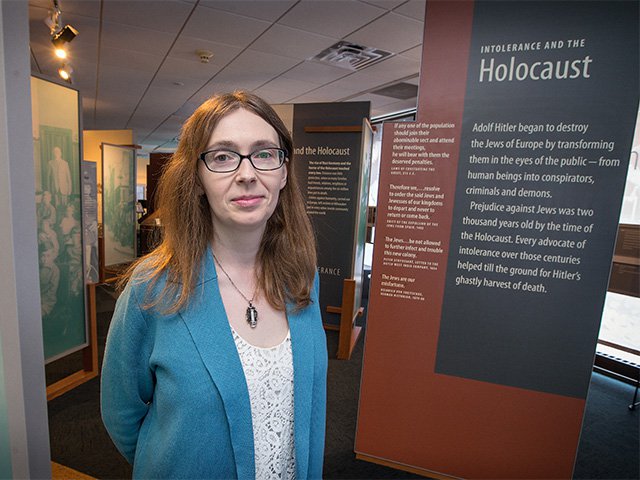From an early age, my parents and grandparents taught my siblings and me to be proud of our Jewish identity and welcome others who were different from us. Most of my friends from school were not Jewish, and many were not white either. I saw (and experienced) bullying in my school directed at people who looked or talked differently, but my friends and I realized early on that there is strength in numbers.
In high school, my teacher encouraged me to submit an essay for the local Holocaust essay contest. The essay conveyed my 14-year-old thoughts about how bystanders — people not taking action — allowed the Holocaust to happen. I won the essay contest, and the prize was a trip to the Holocaust Museum in Washington, D.C.
I fell in love with museums during that trip. I later earned a degree in history at the University of Minnesota with a focus on modern Jewish history and returned to Washington, D.C., to get my master’s degree in museum studies. I served as a graduate researcher on the “State of Deception: The Power of Nazi Propaganda” exhibit at the United States Holocaust Memorial Museum and soon became the educator for the Jewish Historical Society, helping students and adult learners explore the intersections of American democracy and Jewish identity. Both experiences taught me how essential the roles of everyday people in any democracy are, a belief I carry with me to this day.
Today I’m the executive director of the Nathan and Esther Pelz Holocaust Education Resource Center, a program of the Milwaukee Jewish Federation. We study and remember the Holocaust to learn from those lessons of history. While I embrace facts and statistics as a trained historian, I know that people connect to humanity more than they connect to numbers. When a survivor speaks, students listen. When a Holocaust survivor shares their personal story in a classroom, we are teaching the Holocaust beyond the numbers.
Holocaust survivors are aging. Many of them already passed away, and there will probably not be any left in the next 10 years. So, we encourage their children to carry on their family stories. We call these people “2Gs,” the second-generation survivors. People who weren’t in the concentration camps themselves, but whose parents were. They grew up in survivor families.
Many have grown up with this traumatic experience as part of their family story. Some have even gone with their parents to Europe to visit the camps and childhood homes.
Even though these aren’t first-person accounts, we have found that these can still be very powerful presentations because you still have someone with a personal connection to this history.
In April 2021, the Holocaust Education Act was signed into law. The goal was to require Holocaust education for all Wisconsin students. We did not have one lawmaker on either side of the aisle oppose this historic legislation. That was such a wonderful and reaffirming moment to experience, especially during this time when we are so divided.
We know that the Holocaust isn’t a Jewish issue. It’s a universal issue. By studying this history we learn lessons about how to become an upstander — someone who acts or intervenes on behalf of themselves and others — rather than a bystander. Mr. Rogers would call them the doers. They’re the people who speak up if they see something wrong. Fourteen-year-old me recognized that, and many of the students HERC works with make these connections, too. Germany was a democracy when the Nazis came to power. They were one of many parties vying for control. And because ordinary people did nothing to oppose the Nazis, they eventually became a dictatorship. Part of what we teach with Holocaust education is that you are never too young to become an upstander. We’re trying to empower students to recognize that they have power within themselves to make a difference in our world.
We want students to be critical thinkers and make connections between the world today and the world then. We know that there are other genocides in the world that happened before and after the Holocaust. So, we ask students to think about how the Nazis came to power. What messaging did they use and what choices did people have to either accept or reject those messages? I always remind students that propaganda is a two-way street; there needs to be someone who makes the message, and someone willing to accept it, or it doesn’t work.
Ever since the Holocaust ended, there has always been a concern about Holocaust denial — a fear that people would try to minimize it or argue the crimes against humanity didn’t occur. Unfortunately, that concern has proven to be quite accurate.
Holocaust denial is on the rise. We are losing our first-person witnesses to that history. Antisemitism has always been part of our country and it is on the rise. The Jewish Community Relations Council of Milwaukee recently shared that there was an astonishing 482 percent increase in reported antisemitic incidents in Wisconsin from 2015-2020. Teaching the Holocaust is a universal issue because we know if there’s antisemitism, there’s also racism and numerous other forms of discrimination.
In many ways, my journey has come full circle; I now help plan and judge the same Holocaust writing contest that I won as a kid. I also have a daughter of my own now, and she is a 4G, a fourth-generation survivor, through my husband’s late grandmother. What keeps me going is the dream that through my work I am part of a worldwide effort to end genocide and hate so that when she is grown up she can truly say “never again.”
Samantha Abramson’s story was produced by Jen Rubin for Wisconsin Humanities’ storytelling project, Love Wisconsin. It is part of series about people who teach about the Holocaust in schools. See them at lovewi.com/stories.


